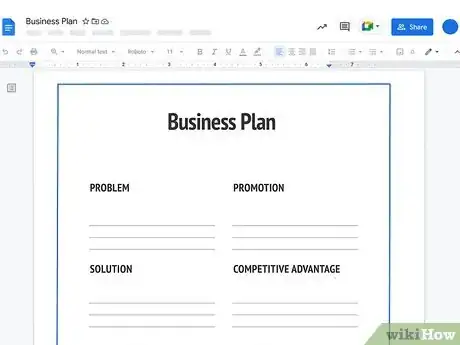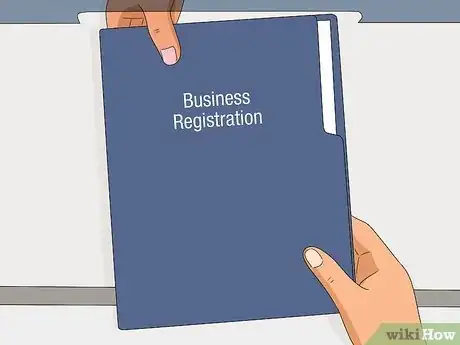This article was co-authored by Helena Ronis. Helena Ronis is Co-founder and CEO of AllFactors, a unified web analytics software to drive company's marketing and business growth. She has worked in product and marketing in the tech industry for over 8 years, and studied Digital Marketing & Analytics at the MIT Sloan School of Management Executive Program.
There are 10 references cited in this article, which can be found at the bottom of the page.
wikiHow marks an article as reader-approved once it receives enough positive feedback. This article received 12 testimonials and 82% of readers who voted found it helpful, earning it our reader-approved status.
This article has been viewed 356,593 times.
Are you looking to start a business as a teen? With a little determination and work, you can totally make your dreams a reality. Starting a business might feel intimidating, and you may not even be sure where to start. But rest assured, with a little help, you'll be on your way in no time. We'll teach you how to brainstorm ideas, do your research, and execute your plan. To learn how to start a business as a teenager, read on!
Steps
Brainstorming Ideas
-
1Turn chores into a service. One of the simplest ways for teenagers to start a business is to turn assigned tasks around the house, in to a service that can be offered to others. Chances are if your parents find value in you doing a particular task, others will too.
- Start a pet walking service. There are many people who are not able to come home during the day to let their pets out. By offering to walk their dog (or another pet) for a small fee, you will not only be providing a valuable service, but will get exercise in the process.
- Clean houses. You're probably already a pro at keeping your room tidy, so why not help others organize and clean their own houses. Start small, by offering to clean or organize one room, before moving on to the whole house.
- Do yard work. Every season provides an opportunity to work outside. Whether it's shoveling snow in the winter, raking leaves in the fall or planting flowers in the spring, there are no shortages of outdoor tasks that you can do for a fee.
-
2Get crafty. Turn your skill of painting or sewing into a business that can reach others on a larger scope. With sites such as Etsy, launching a successful online business, is easy and accessible to anyone with a computer and internet.
- Set up an account on an online site such as Etsy. Listings are active for four months or until they sell. Once purchased, there is a small commission fee and a standard PayPal payment processing fee. [1]
- Take pictures of your artwork or crafts. You'll need a digital camera which can take high resolution shots, as customers will want to see the quality of your work.
Advertisement -
3Name your business. Keep in mind that the name of your business will serve as a first impression to your customers. The name has to encapsulate the practical usefulness of your products or services for your customers, signal your differentiation from competitors and embody the philosophy of your business. [2]
- Brainstorm potential names for your product or service, remembering that, the more your name communicates to consumers about your business, the less effort you must exert to explain it. [3]
- Once you have a name in mind, be sure to research whether an existing business or product goes by the same name. More than likely you will be able to find this information by doing a few, simple searches online, but just in case, you can always use a tool such as The Thomas Registrar, a particularly useful (and free) resource for finding unregistered trademarks [4]
- Consult with friends and family before finalizing the name. Have them write down what comes to mind when they hear the name of your business.
- Revise the name, if necessary, based on feedback you have received.
Conducting Research
-
1Research your market. Find out who your competitors are and what the need is for your chosen product/service. Remember to be specific when doing your research. Even if your product or service fills a unique gap in the market, there are always other companies offering something similar, or there are other ways to satisfy the same customer’s need. The key when thinking about your competition is to learn what makes the customer choose one product or service over another [5]
- Spend some time online looking for initial information regarding your competition and also the market as a whole. For example, do a quick Google search for, “dog walkers near me,” and see what comes up. You’ll get a fairly good idea of how popular the idea is, based on the results.
- Once you’ve determined who your competitors are, don’t be shy about reaching out to them, as they can be a valuable resource for gaining a better understanding as to what to expect and what the actual need is in the market.
-
2Determine your target audience. It is crucial to the success of your business, to figure out who can benefit the most from your product or service. The better you understand your customer, the faster your business will grow. [6] When determining your target audience, you will need to consider demographics such as age, gender, race, etc.
- Create an initial list of potential customers including as much detail as you can think of. For example, my customers will be local families, with two incomes, who own a dog and work long hours. There is no such thing as including too much detail when it comes to defining your audience!
- Survey your target audience to get a sense for whether or not they would use your product or service. Be sure to ask lots of questions to determine the usefulness of your product, with respect to your target population.
-
3Consider financing. If you are not able to fund the startup of your business from money you have saved, you will need to find someone who can help you with financing. Before reaching out to a parent, guardian or another adult for help, be sure to have an outline of how much money you will need, how it will be spent and what your plan is for reimbursing any borrowed funds.
- Create a simple, but detailed budget for your business.
- Assess how much money you already have and what additional funds you will need, based on your budget.
- Detail how you plan to generate money and reimburse investors. People won’t invest in your startup unless they’re confident you’ll generate returns.
- Present both your business plan and budget to potential investors.
Implementing Your Plan
-
1Acquire necessary tools. This can be anything from actual equipment you may need, to personnel you may need to hire. A less is more approach is often useful when initially starting out, particularly when it comes to staying on track with your budget, but do be sure you have the adequate tools needed in order to be successful.
- Don’t hesitate to purchase pre-owned equipment, if applicable, and make use of existing equipment when possible.
- Seek help from friends and family for temporary staffing solutions. This may not be a long-term solution, particularly if your business is successful, but initially, volunteers can be a great way to affordably grow your business.
-
2Market your business. Spreading the word about your business is another crucial step to ensuring your venture is a successful one. These days it is easier than ever to market your product or service, thanks to the internet.
- Start by creating a website for your business. There are many sites available, which are free and easy to use, such as WordPress or Tumblr.
- Utilize social media sites such as Facebook and Twitter to spread the word. It’s essentially free advertising and is a great way to spread the word quickly and easily.
- Create a business card, which contains a few pertinent details about your business, including the website and your contact information.
- Reach out to local businesses. Ask if you can post a flyer with your information, so that other people in the community can contact you.
EXPERT TIPYlva Bosemark is a high school entrepreneur and the founder of White Dune Studio, a small company that specializes in laser cut jewelry. As a young adult herself, she is passionate about inspiring other young adults to turn their passions into business ventures.Jewelry Maker & Entrepreneur
 Ylva Bosemark
Ylva Bosemark
Jewelry Maker & EntrepreneurGet to know your local market. Ylva Bosemark, a jewelry designer and business owner, says: "Craft fairs are a really incredible way to test out your product. Through craft fairs, I got to meet and talk to customers and figure out who my customers were and what demographic my products appealed to. I also got to experiment with price points, because I wasn't sure what people would pay for my products."
-
3Launch your product or service. After putting in the hard work and long hours it takes to launch a new business, you deserve to celebrate. If you're introducing a new product in a physical location, throw a launch party. Similarly, you can offer a "new business special," which features reduced rates, for any services you're providing.
- Contact your neighbors. One of the easiest ways to launch your new business is to reach out to the people next door (literally). Provide your neighbors with a list of your services, a flyer or a business card and ask them to spread the word.
- Have fun! You have successfully started a business as a teenager. You deserve to enjoy the moment and take pride in what you have created.
Taking Your Business to the Next Level
-
1Draft a business plan. If you plan on taking your business to the next level, you'll need to have a plan in place. Using what you learned in the research phase, create a business plan, which is a written description of your business's future, a document that tells what you plan to do and how you plan to do it. [7] Not only will having a business plan help you to stay focused, but it will also serve as a valuable tool for growing your business.
- Gather all of your materials from the research phase, including information about your target audience and market.
- Consult online resources, such as, https://www.wikihow.com/Write-a-Business-Plan, for how to write the plan and what to include.
- It doesn’t matter how you craft your plan or where you store it. You can write in a Google doc, for example. So long as you do your research and present the plan in a logical fashion, you’ll do well!
-
2Register your business. As your business continues to grow and becomes more than just a hobby, you may be required to register it. Additionally, to run your business legally, there are certain federal and state licenses and permits you will need to obtain. [8] Seek the help of a parent, legal guardian or another trusted adult to help you determine if your business does in fact need to be registered.
- Start by consulting online resources such as wikiHow to learn more about the process: https://www.wikihow.com/Register-a-Company
- Before registering your business with state agencies, you will also need to determine if you fit into one of the following categories[9]
:
- A corporation
- A nonprofit organization
- A limited-liability company or partnership
- It might be best to hire an attorney to help you sort out the legal side of your business, but remember to consider your financial situation before doing so and to involve your parent or guardian in the process, as well.
-
3Choose a business location. These days, businesses can be run from just about anywhere. Some businesses can be run successfully from out of the home, while others need a physical location in order to run smoothly.
- Consider what will work best for your business, with respect to your target audience, also keeping in mind your finances.
- If a physical location is necessary, be sure to choose a location that is close to your target audience. You may want to utilize a space that is either free or low in cost, when initially getting your business off the ground. Consider sharing a space. Retail space sharing helps small business owners pool their resources and support each other for shared success. [10]
Warnings
- It is possible that you can lose every cent that you put into your business, so make sure to start small, and to not borrow more than you can pay back.⧼thumbs_response⧽
- Consider rival businesses in the area and as such, change your business model slightly, add items, change items, sell at better prices or make it better quality, to set yourself apart.⧼thumbs_response⧽
References
- ↑ https://www.etsy.com/sell?ref=hdr&from_page=https%3A%2F%2Fwww.etsy.com%2Fseller-handbook%2Farticle%2Ftop-10-tips-for-starting-an-etsy%2F22664153555
- ↑ http://www.entrepreneur.com/article/245594
- ↑ http://www.entrepreneur.com/article/21774
- ↑ http://www.nolo.com/legal-encyclopedia/make-sure-proposed-business-name-available-30195.html
- ↑ http://smallbusinessbc.ca/article/understanding-your-competition/
- ↑ http://www.entrepreneur.com/article/226360
- ↑ http://www.entrepreneur.com/article/247574
- ↑ https://www.sba.gov/category/navigation-structure/starting-managing-business/starting-business/obtain-business-licenses-
- ↑ https://www.sba.gov/content/register-with-state-agencies
About This Article
To start a business as a teenager, consider doing yard work, like shoveling, raking, and mowing, around your neighborhood for a fee. You could also open a pet walking business, or you could start cleaning people's houses. If you'd prefer to do something creative, try making arts and crafts and selling them online through websites like Etsy. Whatever you decide to do, come up with a name for your business that clearly communicates what products or services you offer. To learn how to come up with a business plan and market your business, scroll down!














-Step-12-Version-2.webp)

-Step-20-Version-3.webp)

















-Step-12-Version-2.webp)




































